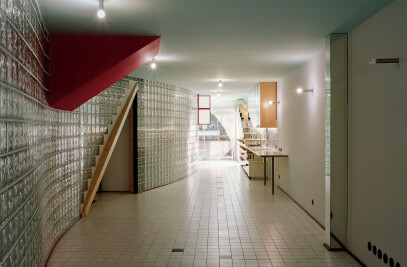A bourgeois 19th century single family house was to be divided into a series of identical studio apartments: four living spaces, some circulation areas and a private backyard. The project happens within a given system of constraints, aiming at an unexpected complexity, finding a certain interest within a very banal set of programs.
Unorthodox everyday spaces are built according to a clearly defined syntax and grammar. The four living rooms are different from each other while sharing the same language, the same set of figures. A defined number of elements - morphemes - within which the project operates: the stepped wall, the curve, two doors (one pink and one green), the striped surface of the floor. The living area becomes a gallery space.
The front facade is almost unchanged. The shabby tiles are replaced by polished green marble contrasting with the roughness of the existing granite frames. A circle of white marble is added to balance the composition.
The back facade is rebuilt. It becomes taller to match the neighbours scale, like a mask or a temple, with two square windows framing interior scenarios. The polished facade has a bold pattern of vertical stripes assembled with white, green and black marble, creating a rich, yet flat, surface. The entrance door is hidden within the pattern and a brass circle ends the piece. The pattern disguises the scale of the building and its program while being unnecessarily proud and exuberant. The back facade becomes a painting for neighbours to look at, a main facade for private use.

































